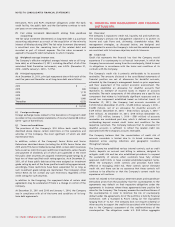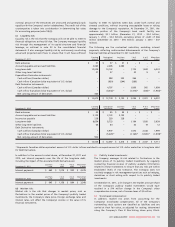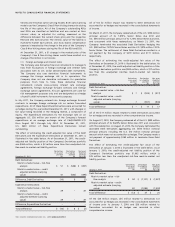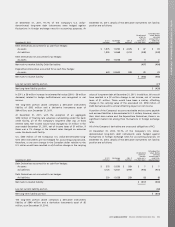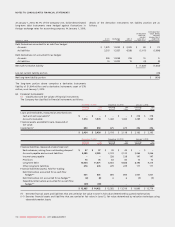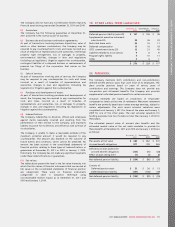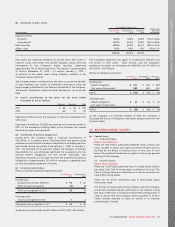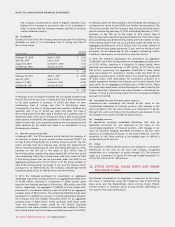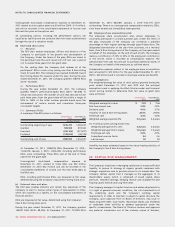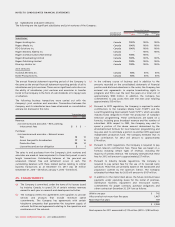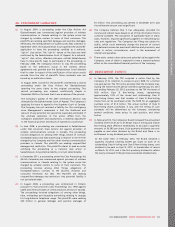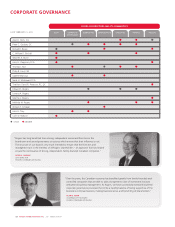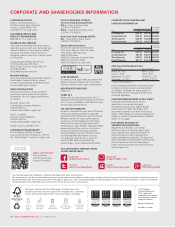Rogers 2011 Annual Report Download - page 126
Download and view the complete annual report
Please find page 126 of the 2011 Rogers annual report below. You can navigate through the pages in the report by either clicking on the pages listed below, or by using the keyword search tool below to find specific information within the annual report.
NOTES TO CONSOLIDATED FINANCIAL STATEMENTS
Unrecognized stock-based compensation expense at December 31,
2011 related to stock-option plans was $9 million (2010 – $11 million),
and will be recorded in the consolidated statements of income over
the next four years as the options vest.
All outstanding options, including the performance options, are
classified as liabilities and are carried at their fair value as determined
through the use of a valuation model.
(b) Restricted share units:
(i) RSU plan:
The RSU plan enables employees, officers and directors of the
Company to participate in the growth and development of
the Company. Under the terms of the plan, RSUs are issued to
the participant and the units issued will cliff vest over a period
not to exceed three years from the grant date.
On the vesting date, the Company shall redeem all of the
participants’ RSUs in cash or by issuing one Class B Non-Voting
share for each RSU. The Company has reserved 4,000,000 Class B
Non-Voting shares for issuance under this plan. During the year
ended December 31, 2011, the Company granted 738,973 RSUs
(2010 – 631,655).
(ii) Performance RSUs:
During the year ended December 31, 2011, the Company
granted 189,571 performance-based RSUs (2010 – 187,508) to
certain key executives. The number of units that vest and will be
paid three years from the grant date will be within a range of
50% to 150% of the initial number granted based upon the
achievement of certain annual and cumulative three-year
non-market targets.
(iii) Summary of RSUs:
A summary of the RSU plans is as follows:
December 31,
2011 December 31,
2010
Number of units
Outstanding, beginning of year 1,616,370 1,060,223
Granted 928,544 819,163
Exercised (416,146) (217,877)
Forfeited (139,813) (45,139)
Outstanding, end of year 1,988,955 1,616,370
At December 31, 2011, 1,988,955 RSUs (December 31, 2010 –
1,616,370; January 1, 2010 – 1,060,223), including performance
RSUs, were outstanding. These RSUs vest at the end of three
years from the grant date.
Unrecognized stock-based compensation expense at
December 31, 2011, related to these RSUs was $32 million
(December 31, 2010 –$22 million) and will be recorded in the
consolidated statements of income over the next three years as
the RSUs vest.
RSUs, including performance RSUs, are measured at fair value,
determined using the Company’s Class B Non-Voting share price.
(c) Deferred share unit plan:
The DSU plan enables directors and certain key executives of the
Company to elect to receive certain types of remuneration in DSUs,
which are classified as a liability on the consolidated statements of
financial position.
DSUs are measured at fair value, determined using the Company’s
Class B Non-Voting share price.
During the year ended December 31, 2011, the Company granted
154,937 DSUs (2010 – 89,136). At December 31, 2011, 751,903 DSUs
(December 31, 2010 – 664,169; January 1, 2010 – 613,777) were
outstanding. There is no unrecognized compensation related to DSUs,
since these awards vest immediately when granted.
(d) Employee share accumulation plan:
The employee share accumulation plan allows employees to
voluntarily participate in a share purchase plan. Under the terms of
the plan, employees of the Company can contribute a specified
percentage of their regular earnings through payroll deductions. The
designated administrator of the plan then purchases, on a monthly
basis, Class B Non-Voting shares of the Company on the open market
on behalf of the employee. At the end of each month, the Company
makes a contribution of 25% to 50% of the employee’s contribution
in the month, which is recorded as compensation expense. The
administrator then uses this amount to purchase additional shares of
the Company on behalf of the employee, as outlined above.
Compensation expense related to the employee share accumulation
plan amounted to $23 million for the year ended December 31, 2011
(2010 – $20 million) and is included in employee salaries and benefits.
(e) Assumptions:
The weighted-average fair value of stock options granted during the
years ended December 31, 2011 and 2010 and the principal
assumptions used in applying the Black-Scholes model and trinomial
option pricing models to determine their fair value at grant date
were as follows:
December 31,
2011 December 31,
2010
Weighted average fair value $ 7.25 $ 7.66
Risk-free interest rate 2.8% 2.9%
Dividend yield 4.0%3.7%
Volatility of Class B Non-Voting shares 29.0%29.8%
Forfeiture rate 3.6%4.0%
Weighted average expected life 5.4 years 5.4 years
For Trinomial option pricing model only:
Weighted average time to vest 2.4 years 2.4 years
Weighted average time to expiry 7.0 years 7.0 years
Employee exit rate 3.6%4.0%
Suboptimal exercise factor 2.6 2.6
Lattice steps 50 50
Volatility has been estimated based on the actual trading statistics of
the Company’s Class B Non-Voting shares.
23. CAPITAL RISK MANAGEMENT:
The Company’s objectives in managing capital are to ensure sufficient
liquidity to pursue its strategy of organic growth combined with
strategic acquisitions and to provide returns to its shareholders. The
Company defines capital that it manages as the aggregate of its
shareholders’ equity (which is comprised of issued capital, share
premium, retained earnings, hedging reserve and available-for-sale
financial assets reserve) and long-term debt.
The Company manages its capital structure and makes adjustments to
it in light of general economic conditions, the risk characteristics of
the underlying assets and the Company’s working capital
requirements. In order to maintain or adjust its capital structure, the
Company, upon approval from its Board of Directors, may issue or
repay long-term debt, issue shares, repurchase shares, pay dividends
or undertake other activities as deemed appropriate under the
specific circumstances. The Board of Directors reviews and approves
any material transactions out of the ordinary course of business,
122 ROGERS COMMUNICATIONS INC. 2011 ANNUAL REPORT


